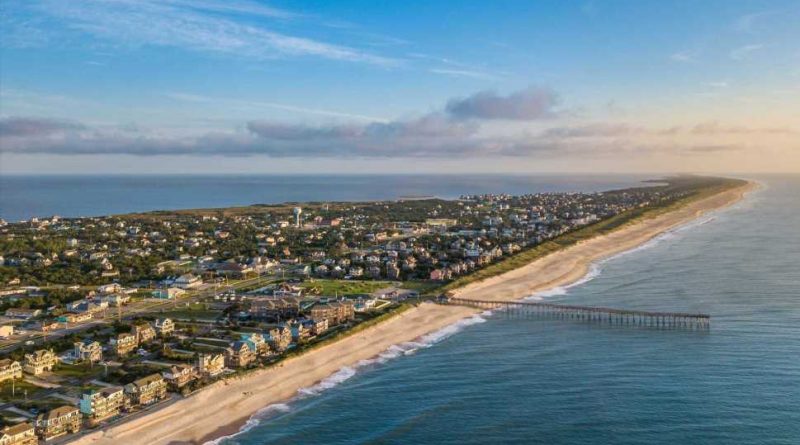Where to Eat, Stay, and Play in North Carolina's Outer Banks
For sandy beaches and legendary surf conditions, to historic lighthouses, shipwreck diving sites, and wild horses, the Outer Banks is a unique East Coast beach vacation. No single island or town bears the official name Outer Banks—rather, the term refers to the string of barrier islands cupping North Carolina’s entire coast, a divide between the inland and the Atlantic.
Born of 19th-century fishing villages and game hunting retreats, this destination now provides a year-round haven for surfers, artists, environmental researchers, families, and retirees. While many businesses close during the quiet winter months, come summertime the islands swell with life, drawing visitors to the family-friendly beaches and historic attractions.
Towns on the islands, running north to south, range from sleepy fishing hubs to commercial centers with ritzy, seaside resorts. Their small sizes make it easy to explore several towns in a day, by following N.C. Highway 12 through each. The 148-mile, mostly two-lane highway lives up to its name as the Outer Banks Scenic Byway—it traverses the Cape Hatteras National Seashore between towering sand dunes, past expansive views of the sound and ocean, and through each town before ending (quite literally) on the beach in northern Corolla. Here’s what to do in Outer Banks, and everything else you need to know to plan a visit.
All listings featured in this story are independently selected by our editors. However, when you book something through our retail links, we may earn an affiliate commission.
Getting there
Unless travelers charter a boat or plane, they reach the Outer Banks via car. Virginia’s Norfolk International Airport is the closest if you arrive by air. From there, rent a car and make the 1.5-hour drive south. A bridge connects the North Carolina mainland to the town of Kitty Hawk. Once on the island follow U.S. 158 South to get to the towns of Kill Devil Hills, Nags Head, and Hatteras Island. For the northern towns of Southern Shores, Duck, and Corolla, follow N.C. Highway 12 north along the scenic, two-lane road that hugs the island’s sound-side. Bridges connect the islands together, except for Ocracoke Island, which is reached by the NCDOT Ferry.
What to do in the Outer Banks
Pretty much any beach-oriented activity thrives on these sandy shores: surfing, swimming, strolling at the water’s edge, sunbathing, picnicking, skim boarding, fishing. Plentiful public access points lead beachgoers over the dune line that separates the shore from the road, with the exception of Southern Shores and Duck. While public parking is available at many beaches, the high volume of visitors in-season makes carpooling a good idea.
Southern Shores and Duck beaches, which are public, can only be reached by private access points belonging to cottages or home-owners’ associations. They provide residents and guests a quiet escape to savor the surf and sand without the crowds.
The Outer Banks’ ocean varies from swimmable surf to hazardous conditions. Each island’s west side, however, has a sound with calmer, shallow waters for swimming and watersports. Companies such as Nor’Banks Sailing and Watersports outfit both experienced sportsmen and newcomers for kayaking, standup paddle boarding, jet-ski rides, sailing, parasailing, and cruises in the Currituck Sound.
The Outer Bankswaters teem with game fish like bluefin tuna, cobia, and marlin. Private charters from the Oregon Inlet Fishing Center whisk both amateur anglers and old salts into the Gulf Stream current for half- or full-day fishing trips. Keep what you catch (within North Carolina Fishing Regulations); local restaurants like Blue Water Grill & Raw Bar and Basnight’s Lone Cedar Cafe offer the option to cook your fish for you.
No sea legs? No problem. Climb atop the Currituck Beach Lighthouse, Bodie Island Lighthouse, and Hatteras Lighthouse for striking views of the mile-wide islands parting the ocean and sounds. Take to the skies hang gliding at Jockey’s Ridge State Park, home to the largest living sand dune on the East Coast, with Kitty Hawk Kites. Or, stay at sea level by visiting the spot where the first flight occurred, at the Wright Brothers National Memorial in Kill Devil Hills.
For shopping, follow the town of Duck’s sound-side boardwalk or central sidewalk for an entirely local and walkable shopping corridor. Gear up for water sports at Duck Village Outfitters with new and used surfboards and kayaks. Find Bauhaus-style decor and eco-friendly homeware at Modern Beach House, and browse two floors of titles at Island Books. Between the boutiques and galleries, plenty of bistros, wine bars, and coffee shops line the boardwalk and road through town for your choice of pick-me-up.
Where to eat
Homegrown roasters and independent coffee shops are fixtures within the Outer Banks community. Front Porch Café roasts more than 20 different coffee bean varieties in house, and its three locations feature local artists’ paintings, photography, and ceramics. Duck’s Cottage, a cozy one-room coffeehouse, is also part indie bookstore so you can enjoy a latte while perusing paperbacks.
John’s Drive-In has been an Outer Banks cornerstone for four generations. The window-service joint across the road from the beach in Kitty Hawk specializes in coastal Carolina mainstays like battered fish baskets and barbecue sandwiches. Only open for lunch in the warmer months, they almost always have a line of people waiting for thick milkshakes and crunchy fried mahi sandwiches (look for ‘dolphin sub’ on the menu).
For elevated food, drink, and hospitality with a dreamy backdrop, make dinner reservations at The Blue Point. This 32-year-old Duck establishment pairs classic Southern staples like pimento cheese and sweet-potato ham biscuits with New South dishes: Go for the tuna carpaccio, or seared sea scallops over curried lentils. Grab a seat at their outdoor bar during golden hour for a waterfront sunset, accompanied by a cocktail or bottle of Burgundy.
Where to stay
Most people visiting the Outer Banks stay in vacation rental houses, which can range from 1920s cedar-shake cottages to palatial homes that sleep up to 20 people. If you don’t want to commit to an entire house, there are a handful of chain hotel brands and boutique inns. Just steps off the dirt road in Historic Corolla Village, the Corolla Village Inn (rooms from $265 per night) offers Cape Cod-inspired rooms and suites behind a veil of live oaks. A communal fireside lounge and spacious front porches invite guests to unwind with a glass of wine at the end of the day.
For a boutique hotel feel but with all the amenities of a resort, you can’t go wrong with The Sanderling (rooms from $399 per night), a longtime oceanfront favorite just north of Duck that’s family-friendly, and comes equipped with a pool, tennis courts, spa, and several spots for meals—from a casual poolside cafe to upscale fine-dining spot overlooking the sound.
Mom’s Sweet Shop in Kill Devil Hills has earned a spot at the cool kids’ table by pairing vintage clothing, accessories, and skate gear with a soft-serve/smoothie counter. This nouveau-cottage-style shop also surprises many with a one-bedroom apartment (rooms from $195 per night) available as a nightly accommodation. The shop’s boho aesthetic inspires every inch of the open floor plan, and its location just one block from the beach positions guests within 15 minutes of shops and restaurants throughout Kitty Hawk, Kill Devil Hills, and Nags Head—in other words, come here for that small-town flavor that brought you to the Outer Banks in the first place.
Source: Read Full Article



